Explore
the Adirondack Mountains:
Nature Walk
12 July 2012
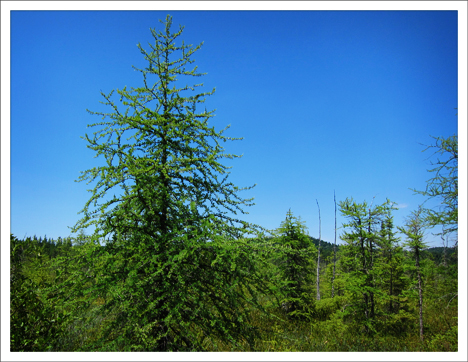 Tamaracks on Barnum Bog (12 July 2012)
Tamaracks on Barnum Bog (12 July 2012)
On 12 July, VIC naturalist Brian McAllister led a nature walk focused on three different kinds of habitats: mixed forest and two types of Adirondack wetland: bog and marsh. We covered the Boreal Life Trail and the Barnum Brook Trail.
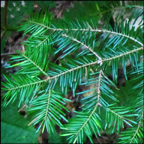 The
wooded area of the Boreal Life Trail
near the gazebo provides an example of mixed forest, consisting
of both deciduous trees and conifers. Red Spruce and Balsam Fir thrive here, alongside Hemlock, Red Maple, and Yellow Birch. Both
Red Spruce and Balsam Fir are members of the Pine family. Red
Spruce trees have single, four-sided needles 1-2 centimeters long,
which Balsam Fir has fragrant, flat needles 1-2.5 centimeters
long with two silvery lengthwise lines or grooves below. The understory
is composed of club mosses (such as Tree Club Moss), shrubs (such
as Hobblebush and Wild Raisin), ferns (such as the Evergreen
Wood Fern), and wildflowers (such as Purple
Trillium, Canada
Mayflower, Clintonia,
and Common Wood Sorrel).
The
wooded area of the Boreal Life Trail
near the gazebo provides an example of mixed forest, consisting
of both deciduous trees and conifers. Red Spruce and Balsam Fir thrive here, alongside Hemlock, Red Maple, and Yellow Birch. Both
Red Spruce and Balsam Fir are members of the Pine family. Red
Spruce trees have single, four-sided needles 1-2 centimeters long,
which Balsam Fir has fragrant, flat needles 1-2.5 centimeters
long with two silvery lengthwise lines or grooves below. The understory
is composed of club mosses (such as Tree Club Moss), shrubs (such
as Hobblebush and Wild Raisin), ferns (such as the Evergreen
Wood Fern), and wildflowers (such as Purple
Trillium, Canada
Mayflower, Clintonia,
and Common Wood Sorrel).
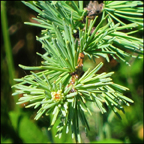 The
boardwalk area of the Boreal Life Trail
provides an example of an Adirondack
bog. This habitat is a nutrient-poor, acidic wetland dominated
by sphagnum mosses, sedges, and shrubs and evergreen trees rooted
in deep peat. The two main trees found on Barnum Bog are
Black Spruce and Tamarack. Tamaracks, which are also known as
the Eastern Larch or American Larch, are coniferous (cone-bearing)
trees which behave like a deciduous tree; the needles of the Tamarack
turn a golden yellow in fall and drop to the ground, appearing
again in the spring. Tamaracks thrive in the acidic environment
of bogs. Both the Tamaracks and Black Spruce in Barnum Bog are
quite small, because the harsh environment causes them to grow
very slowly, so a tree only a few feet high may be quite old.
The
boardwalk area of the Boreal Life Trail
provides an example of an Adirondack
bog. This habitat is a nutrient-poor, acidic wetland dominated
by sphagnum mosses, sedges, and shrubs and evergreen trees rooted
in deep peat. The two main trees found on Barnum Bog are
Black Spruce and Tamarack. Tamaracks, which are also known as
the Eastern Larch or American Larch, are coniferous (cone-bearing)
trees which behave like a deciduous tree; the needles of the Tamarack
turn a golden yellow in fall and drop to the ground, appearing
again in the spring. Tamaracks thrive in the acidic environment
of bogs. Both the Tamaracks and Black Spruce in Barnum Bog are
quite small, because the harsh environment causes them to grow
very slowly, so a tree only a few feet high may be quite old.
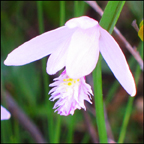 Shrubs
growing on Barnum Bog include evergreen members of the heath family,
such as Sheep
Laurel, Bog
Laurel, Bog Rosemary, Leatherleaf, and Labrador
Tea. We also examined some of the many wildflowers that thrive
on Barnum Bog, including several types of carnivorous plants:
the Roundleaf Sundew, the Pitcher
Plant, and the Bladderwort. The latter is a submersed free-floating
plant featuring tiny bladders attached to the leaves, which trap
and digest very tiny animals. A number of bog-loving orchids were
blooming during our visit, including the Rose
Pogonia, and White Fringed Orchid. Birds which nest in Barnum
Bog include the Lincoln's
Sparrow and the Palm
Warbler.
Shrubs
growing on Barnum Bog include evergreen members of the heath family,
such as Sheep
Laurel, Bog
Laurel, Bog Rosemary, Leatherleaf, and Labrador
Tea. We also examined some of the many wildflowers that thrive
on Barnum Bog, including several types of carnivorous plants:
the Roundleaf Sundew, the Pitcher
Plant, and the Bladderwort. The latter is a submersed free-floating
plant featuring tiny bladders attached to the leaves, which trap
and digest very tiny animals. A number of bog-loving orchids were
blooming during our visit, including the Rose
Pogonia, and White Fringed Orchid. Birds which nest in Barnum
Bog include the Lincoln's
Sparrow and the Palm
Warbler.
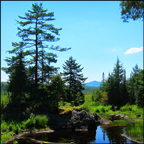 The
overlooks along the Barnum Brook Trail
provide excellent views of Heron Marsh -- another type of Adirondack
wetland. Like other Adirondack
marshes, Heron Marsh is a mineral-rich wetland where the dominant
vegetation consists of herbaceous plants that are rooted in hydric
soils, but not in peat. It has both open water, where White
Water-lily and Yellow Pond Lily bloom and water fowl, such
as Mallard,
American
Black Duck, and Ring-necked
Duck can be seen. Heron Marsh also has islands of low-growing
vegetation, dominated by grasses and sedges, where American
Bittern hunt for food. Pickerelweed
and Blue
Flag Iris flourish at lower water depths. Red-winged
Blackbirds are commonly seen perching on snags and shrubs
on the marsh. Swamp
Sparrows nest among the cattails and shrubs along the margins
of the marsh. Heron Marsh also has two active beaver lodges.
The
overlooks along the Barnum Brook Trail
provide excellent views of Heron Marsh -- another type of Adirondack
wetland. Like other Adirondack
marshes, Heron Marsh is a mineral-rich wetland where the dominant
vegetation consists of herbaceous plants that are rooted in hydric
soils, but not in peat. It has both open water, where White
Water-lily and Yellow Pond Lily bloom and water fowl, such
as Mallard,
American
Black Duck, and Ring-necked
Duck can be seen. Heron Marsh also has islands of low-growing
vegetation, dominated by grasses and sedges, where American
Bittern hunt for food. Pickerelweed
and Blue
Flag Iris flourish at lower water depths. Red-winged
Blackbirds are commonly seen perching on snags and shrubs
on the marsh. Swamp
Sparrows nest among the cattails and shrubs along the margins
of the marsh. Heron Marsh also has two active beaver lodges.
